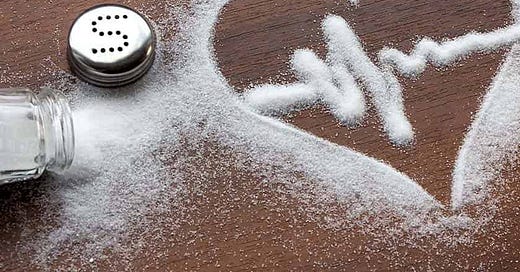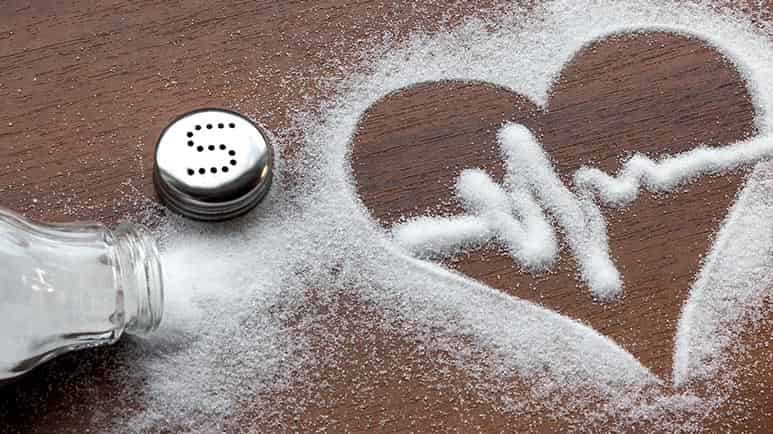Why Europe No Longer Recommends Strict Salt Restriction for Patients with Heart Failure
Europe has revamped its heart failure guidelines, abandoning strict salt limits in favor of personalized nutrition based on the latest research.
STORY AT-A-GLANCE
European health authorities no longer recommend strict salt restriction for heart failure patients, as recent studies show limited benefits for mortality and hospitalization rates
The traditional approach of strict sodium restriction negatively impacts quality of life and leads to poor adherence among heart failure patients
Individual factors like genetic predisposition, lifestyle and metabolic status should guide personalized dietary plans rather than universal salt restrictions
Research emphasizes the importance of sodium-to-potassium ratio, with natural salts containing higher potassium levels than processed table salt
As a general rule, your ideal sodium level is 139, with an optimal range of 136 to 142. If it is much lower, you probably need to eat more natural salt. If it’s higher, you’ll likely want to restrict your processed salt intake
Heart failure has long been managed with strict dietary guidelines, particularly emphasizing the reduction of salt intake. For decades, this restriction was believed to be essential in controlling symptoms and preventing hospitalizations. However, while excessive sodium intake may lead to fluid retention, increasing the workload on the heart and exacerbating symptoms such as swelling and shortness of breath, strict salt restriction is also problematic.
Heart failure is a chronic, progressive condition where the heart muscle is unable to pump enough blood to meet your body's needs for blood and oxygen. While the heart hasn’t stopped working, its pumping power is weaker than normal or it is not able to fill with enough blood.
Historically, limiting salt intake was seen as a straightforward strategy to mitigate heart failure, aligning with the body's need to maintain fluid balance and reduce cardiac stress. However, recent advancements and studies have begun to challenge this longstanding recommendation.
Challenging the Benefits of Strict Salt Restriction in Heart Failure
New evidence suggests that strict sodium and fluid restrictions may not be universally beneficial and could, in some cases, negatively impact heart failure patients' quality of life. This shift in understanding has prompted a significant reevaluation of existing guidelines.
In response to these emerging findings, European health care authorities have updated their heart failure guidelines. The European Journal of Heart Failure published a position paper in 2024 stating, “Recent data challenge the beneficial role of dietary sodium and fluid restriction in HF [heart failure].”1 This statement marks a departure from previous recommendations, advocating for a more individualized approach to dietary management in heart failure patients.
Early studies supported the notion that limiting salt intake was essential for controlling heart failure symptoms and preventing hospitalizations. However, these restrictions may lead to adverse effects such as persistent thirst and reduced enjoyment of meals. Observational studies have also highlighted poor adherence to sodium and fluid restrictions, often resulting in elevated plasma renin activity, which could counteract the intended therapeutic effects.
Lack of Significant Mortality and Hospitalization Benefits
Recent studies have also revealed that strict sodium restrictions may not substantially reduce mortality or hospitalization rates in patients with heart failure. According to the European Journal of Heart Failure, contemporary evidence does not support the previously held belief that low-sodium diets lead to better survival outcomes for all heart failure patients.2
Research published in Progress in Cardiovascular Diseases further emphasizes that limiting salt intake to less than 5 grams per day does not confer significant advantages in preventing adverse heart failure events.3 This again challenges the conventional approach and suggests that universal strict sodium restriction may not be as beneficial as once thought.
Lifestyle Factors Influence Heart Failure Outcomes
Research also indicates that the effects of sodium intake on heart failure outcomes are not uniform across all patients. One study, published in Circulation: Heart Failure, highlights that lifestyle factors, including smoking, obesity, physical activity and diet, significantly influence heart failure risk, regardless of genetic predisposition.4 This variability underscores the importance of tailoring dietary guidelines to each patient's unique health circumstances.
For instance, by allowing a moderate sodium intake, patients enjoy a more varied diet, which contributes to higher satisfaction and adherence to dietary recommendations.5 This shift not only supports better physical health but also enhances mental and emotional well-being, making the management of heart failure more sustainable for patients.
So, instead of enforcing strict sodium and fluid restrictions universally, health care providers are now encouraged to consider individual patient factors such as genetic risk and metabolic status.6 This tailored strategy helps in optimizing treatment outcomes while minimizing adverse effects associated with overly restrictive diets.
Personalized Dietary Plans for Heart Failure Management
Adopting personalized dietary plans is essential for effective heart failure management. Tailoring sodium intake to individual patient profiles, considering factors such as genetic predisposition and metabolic status, ensures that dietary restrictions are both effective and sustainable.7
Collaborative care involving multidisciplinary teams, such as holistic dietitians, cardiologists and primary care providers, improve heart failure management by addressing various aspects of patient care, including lifestyle modifications and dietary interventions.8
Community-based support programs also play a role in enhancing patient education and adherence to dietary guidelines for heart failure management. Initiatives such as group workshops, cooking classes and support groups offer valuable resources and encouragement, fostering a supportive environment where patients can share experiences, exchange tips and stay motivated to maintain healthy lifestyle changes.
These programs help patients better understand the importance of dietary modifications and provide practical strategies for implementing them in daily life.9 The move toward personalized nutrition in heart failure care highlights the importance of ongoing research and evidence-based practice. As our understanding of heart failure management evolves, so too must our approaches to patient care.
By embracing these new perspectives on sodium, the updated European guidelines pave the way for more effective, patient-centered care and sets a new standard for how we should think about and implement dietary interventions in chronic disease management.
The Importance of the Sodium to Potassium Ratio
The type of salt matters when it comes to its role in your health, and so does its relationship with potassium, a naturally occurring mineral your body uses as an electrolyte. It's generally recommended that you consume five times more potassium than sodium, but most Americans get the opposite ratio, eating two times more sodium than potassium.
If you eat a lot of processed foods, which contain processed table salt, your sodium to potassium ratio is likely out of balance. While conventional health care practitioners may suggest you remedy this by limiting salt intake, focusing on increasing potassium is key. Research shows an association between higher potassium intake and lower blood pressure, regardless of sodium intake.10
Even the American Heart Association explains, “Foods with potassium can help control blood pressure by blunting the effects of sodium. The more potassium you eat, the more sodium you process out of the body.”11 Examples of potassium-rich foods include oranges, cantaloupe, yogurt and spinach.12
In addition to increasing your potassium intake, it’s possible to improve your sodium to potassium ratio just by switching the type of salt you eat — from table salt to natural varieties such as pink Himalayan. In the U.S., the majority of salt that’s consumed comes from processed foods. This processed salt contains 97.5% sodium chloride, with about 39% sodium.
Natural salt, however, is higher in potassium than processed salt. Compared to iodized white table salt, which contains 151.68 milligrams per kilogram (mg/kg) of potassium, pink Himalayan salt contains 2,085.71 mg/kg.13 If you're unsure how much sodium or potassium you’re consuming, use a food tracking app, which allows you to enter the foods you eat and calculate your sodium to potassium ratio automatically.
How Much Salt Is Ideal?
Your body has a built-in “salt thermostat” that lets you know how much you need by regulating your craving for salt. It’s a good idea to listen to your body and, if you’re craving salt, consume more. If you sweat profusely, either through exercise or sauna use, for example, or drink caffeinated beverages, you automatically will need more salt than usual.
A number of medical conditions also increase sodium loss or prevent your body from absorbing salt well. This includes inflammatory bowel diseases, sleep apnea, adrenal deficiency, bariatric surgery, kidney diseases, hypothyroidism and celiac disease. So, if you have any of these, you may need a bit more salt in your diet to compensate.
Some experts recommend eating about 3,500 mg of sodium daily, which is far more than the American Heart Association’s recommended maximum limit of 2,300 mg a day, and their “ideal limit” of less than 1,500 mg a day.14
If you’re not sure whether you’re eating the right amount of salt for your body, you can also get a fasting chemistry profile that shows your serum sodium. As a general rule, your ideal sodium level is 139, with an optimal range of 136 to 142. If it is much lower, you probably need to eat more natural salt. If it’s higher, you’ll likely want to restrict your processed salt intake.
There are also some salt-sensitive subpopulations that may need to limit their salt intake to 2,300 mg per day. This includes those with:
Endocrine disorders
High aldosterone levels
Cushing’s syndrome
Elevated cortisol
Liddle syndrome, a rare condition affecting about 1 in 1 million individuals, causing them to retain too much salt. If treated with amiloride, salt intake probably does not need to be restricted
Disclaimer: The entire contents of this website are based upon the opinions of Dr. Mercola, unless otherwise noted. Individual articles are based upon the opinions of the respective author, who retains copyright as marked.
The information on this website is not intended to replace a one-on-one relationship with a qualified health care professional and is not intended as medical advice. It is intended as a sharing of knowledge and information from the research and experience of Dr. Mercola and his community. Dr. Mercola encourages you to make your own health care decisions based upon your research and in partnership with a qualified health care professional. The subscription fee being requested is for access to the articles and information posted on this site, and is not being paid for any individual medical advice.
If you are pregnant, nursing, taking medication, or have a medical condition, consult your health care professional before using products based on this content.





